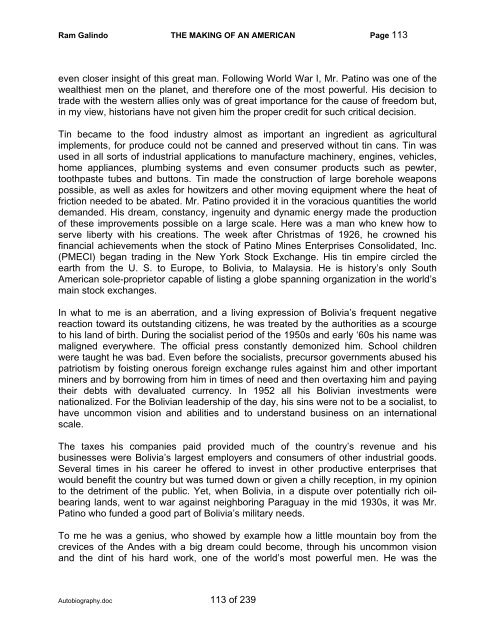Autobiography - The Galindo Group
Autobiography - The Galindo Group
Autobiography - The Galindo Group
Create successful ePaper yourself
Turn your PDF publications into a flip-book with our unique Google optimized e-Paper software.
Ram <strong>Galindo</strong> THE MAKING OF AN AMERICAN Page 113<br />
even closer insight of this great man. Following World War I, Mr. Patino was one of the<br />
wealthiest men on the planet, and therefore one of the most powerful. His decision to<br />
trade with the western allies only was of great importance for the cause of freedom but,<br />
in my view, historians have not given him the proper credit for such critical decision.<br />
Tin became to the food industry almost as important an ingredient as agricultural<br />
implements, for produce could not be canned and preserved without tin cans. Tin was<br />
used in all sorts of industrial applications to manufacture machinery, engines, vehicles,<br />
home appliances, plumbing systems and even consumer products such as pewter,<br />
toothpaste tubes and buttons. Tin made the construction of large borehole weapons<br />
possible, as well as axles for howitzers and other moving equipment where the heat of<br />
friction needed to be abated. Mr. Patino provided it in the voracious quantities the world<br />
demanded. His dream, constancy, ingenuity and dynamic energy made the production<br />
of these improvements possible on a large scale. Here was a man who knew how to<br />
serve liberty with his creations. <strong>The</strong> week after Christmas of 1926, he crowned his<br />
financial achievements when the stock of Patino Mines Enterprises Consolidated, Inc.<br />
(PMECI) began trading in the New York Stock Exchange. His tin empire circled the<br />
earth from the U. S. to Europe, to Bolivia, to Malaysia. He is history’s only South<br />
American sole-proprietor capable of listing a globe spanning organization in the world’s<br />
main stock exchanges.<br />
In what to me is an aberration, and a living expression of Bolivia’s frequent negative<br />
reaction toward its outstanding citizens, he was treated by the authorities as a scourge<br />
to his land of birth. During the socialist period of the 1950s and early ‘60s his name was<br />
maligned everywhere. <strong>The</strong> official press constantly demonized him. School children<br />
were taught he was bad. Even before the socialists, precursor governments abused his<br />
patriotism by foisting onerous foreign exchange rules against him and other important<br />
miners and by borrowing from him in times of need and then overtaxing him and paying<br />
their debts with devaluated currency. In 1952 all his Bolivian investments were<br />
nationalized. For the Bolivian leadership of the day, his sins were not to be a socialist, to<br />
have uncommon vision and abilities and to understand business on an international<br />
scale.<br />
<strong>The</strong> taxes his companies paid provided much of the country’s revenue and his<br />
businesses were Bolivia’s largest employers and consumers of other industrial goods.<br />
Several times in his career he offered to invest in other productive enterprises that<br />
would benefit the country but was turned down or given a chilly reception, in my opinion<br />
to the detriment of the public. Yet, when Bolivia, in a dispute over potentially rich oilbearing<br />
lands, went to war against neighboring Paraguay in the mid 1930s, it was Mr.<br />
Patino who funded a good part of Bolivia’s military needs.<br />
To me he was a genius, who showed by example how a little mountain boy from the<br />
crevices of the Andes with a big dream could become, through his uncommon vision<br />
and the dint of his hard work, one of the world’s most powerful men. He was the<br />
<strong>Autobiography</strong>.doc 113 of 239


